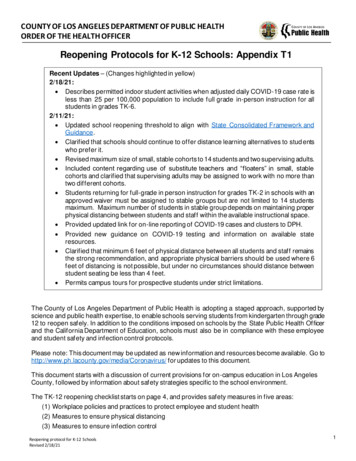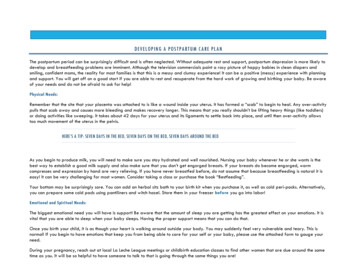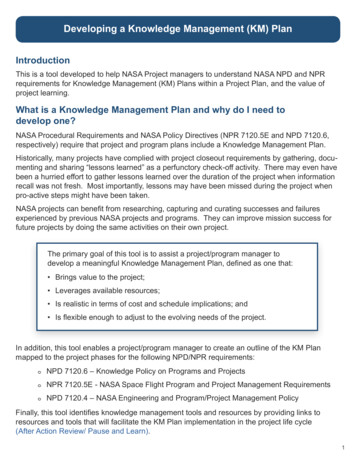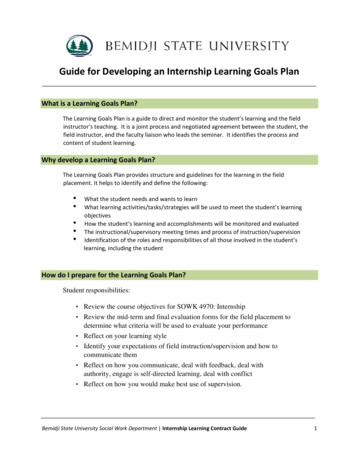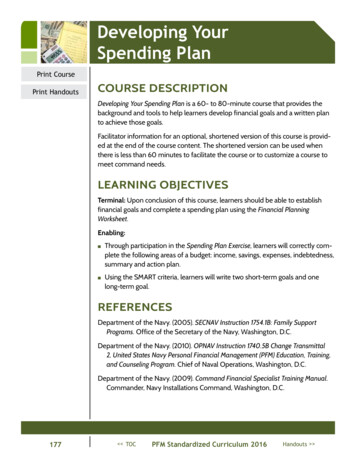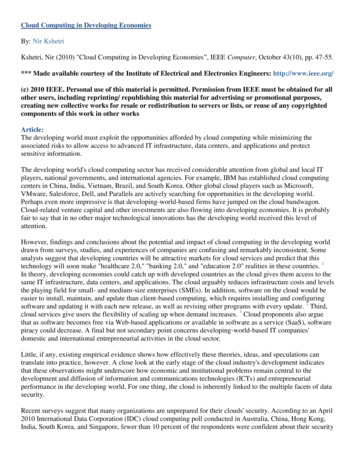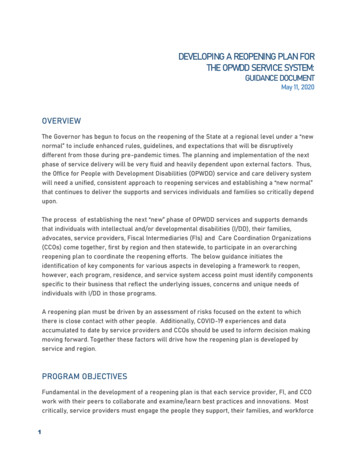
Transcription
DEVELOPING A REOPENING PLAN FORTHE OPWDD SERVICE SYSTEM:GUIDANCE DOCUMENTMay 11, 2020OVERVIEWThe Governor has begun to focus on the reopening of the State at a regional level under a “newnormal” to include enhanced rules, guidelines, and expectations that will be disruptivelydifferent from those during pre-pandemic times. The planning and implementation of the nextphase of service delivery will be very fluid and heavily dependent upon external factors. Thus,the Office for People with Development Disabilities (OPWDD) service and care delivery systemwill need a unified, consistent approach to reopening services and establishing a “new normal”that continues to deliver the supports and services individuals and families so critically dependupon.The process of establishing the next “new” phase of OPWDD services and supports demandsthat individuals with intellectual and/or developmental disabilities (I/DD), their families,advocates, service providers, Fiscal Intermediaries (FIs) and Care Coordination Organizations(CCOs) come together, first by region and then statewide, to participate in an overarchingreopening plan to coordinate the reopening efforts. The below guidance initiates theidentification of key components for various aspects in developing a framework to reopen,however, each program, residence, and service system access point must identify componentsspecific to their business that reflect the underlying issues, concerns and unique needs ofindividuals with I/DD in those programs.A reopening plan must be driven by an assessment of risks focused on the extent to whichthere is close contact with other people. Additionally, COVID-19 experiences and dataaccumulated to date by service providers and CCOs should be used to inform decision makingmoving forward. Together these factors will drive how the reopening plan is developed byservice and region.PROGRAM OBJECTIVESFundamental in the development of a reopening plan is that each service provider, FI, and CCOwork with their peers to collaborate and examine/learn best practices and innovations. Mostcritically, service providers must engage the people they support, their families, and workforce1
in the development and implementation of a reopening strategy. Each provider should developdetailed reopening plans tailored to address the following areas: Residential, Day and Community Service/Office Location Safety PlanPerson-centered PlanningWorkforce PlanTraining PlanInfection Control and Prevention PlanCommunication PlanFinancial PlanPeriodic Review and Updating of PlansThese plans need to be flexible and include mitigation and preparation strategies to preparefor circumstances/environmental changes within the service providers’/FIs’/CCOs’ controlversus those that are driven from outside their catchment area (county by county). It iscritically important that upon reopening the service system, service providers, FIs, and CCOsreview and monitor the plans’ implementation, note any changes in direction or modification tothe plans, and continually address challenges encountered.KEY PARTNERS IN SUCCESSIndividuals Supported and Their FamiliesThe development of any plan must include the engagement of those impacted, with individualsand families being at the center. How will services need to change to meet their needs? Howwill they be able to evaluate the level of risk associated with a service, and how will theyexercise choice to participate or not? Individuals and families will provide valuable input inevaluating organizational performance throughout the public health emergency, identifyingthings that went well and those needing improvement. They will also learn more about theissues and challenges organizations faced throughout the crisis. From this, individuals andfamilies can provide valuable input and additional critical thinking to the finalization of theoverall reopening plan.Hospitals, County Departments of Health (CDOH), Office of Emergency Management (OEM) &First RespondersUsing the experience of the COVID-19 public health crisis, service providers, FIs and CCOs willneed to examine mechanisms to strengthen relationships with local hospitals (with a keenfocus on non-discriminatory access to care practices, inclusive visitor policies and2
comprehensive discharge planning), County DOH (reporting/testing/contact tracing), OEMofficials (PPE) and First Responders (emergency medical services). These entities requiredeeper understanding of: the I/DD care delivery system the nuances and unique needs of the I/DD population the essential nature of I/DD service staff the valuable role service providers, FIs, and CCOs can play as partners to thehealthcare system in effectively supporting individuals with I/DDThese partnerships are critically important as they impact the ability to obtain personalprotective equipment (PPE), testing/contact tracing of individuals and employees for infectiousdisease, access to population health data, and the delivery of emergency medical services.REIMAGINING SERVICE DELIVERYA key component of developing and implementing a reopening plan involves how the State andits partners answer this question: How do we take the best practices in service delivery thatwe are learning as a result this public health emergency and incorporate those practices intomodels that will best meet people’s needs in the “new normal?” For example, telemedicine isbeing used to deliver various health, mental/behavioral health services to people in theirhomes through virtual technology. This technology is also used for remote emergency roomservices. As a result, telemedicine is enabling people to obtain services in a timely, effectiveand efficient manner.The use of virtual technology was expanded to cover the delivery of virtual care management,community habilitation and day services as well as other creative and innovative mechanismsemployed by service providers and CCOs during the COVID-19 crisis. It is critical thatgovernment allow such innovation to continue beyond the current State of Emergency. The useof virtual technology must be permanent and long-term and, therefore, serviceproviders/FIs/CCOs must embrace it from financial, training, workforce, and servicetransformation perspectives.The reopening plan must also address the development of contingency plans should anoutbreak reoccur and identify mitigation strategies to ensure services continue to be deliveredin full.From this reopening plan, each service provider, FI and CCO will need to take steps to preparefor the reopening process. This, along with the following framework, will assist and guide eachentity to open as safely as possible.3
TYPES/CATEGORIES OF PLANS NECESSARY TO RE-OPENResidential, Day and Community Service/Office Location Safety Plan:A Residential, Day and Community Service/Office Location Safety Plan will need to addressseveral areas, including: How and with what frequency to clean and disinfect certified homes/servicelocation/office areas, especially common areas such as restroomskitchens/breakrooms, and high-touch areas such as door handles, light switches, etc. How to implement social distancing, including as individuals receivingservices/employees enter and leave the residence/service location/office (includingelevator use) and during meal-breakso For certified homes: plan for mealtime considerationso For day services and office locations: consider an evaluation of whether to allowthe use of kitchens and breakrooms, and if so, when and how should this occur Whether changes should be made to day services, employee work schedules, or thephysical space to decrease contact between individuals or employees Limits to be placed on the number of individuals/staff in a service location andemployees in an office settingo For residences: consider a re-evaluation of the home size, shared bedrooms,and the number of individuals living together How to monitor individual/employee health, including whether and how often to checktemperatures, among other COVID-19 protocols including the implementation of selfassessment checklists Whether and to what extent there is a need for PPE for both employees and individuals How to re-engage individuals and staff into the community with specific guidance forvarious settings and activities, including transportation and use of mass transit What coordination is needed between the service provider/CCO/FI and its landlord forscenarios in which the service/office location is a leased or shared space Whether there a need to increase air flow and filtering options in the HVAC systems (inboth leased and owned spaces)Person-centered Planning:Service providers/FIs, working with CCOs, individuals, and their families, should develop anexpedited person-centered planning process focused on the “new normal.” In addition, withouta vaccine and after months of disrupted routines, isolation, boredom, and lives turned upsidedown, re-entry for both individuals and their families will not be without its challenges.Service providers, FIs, and CCOs will work collectively to perform comprehensive member riskassessments to ensure the proper treatments, supports, services, and infection preventionmeasures are tailored to the individual’s personal need. For individuals and families hesitant4
to move forward with face-to-face interactions with service provider staff and/or CareManagers, long-term options for telecommunications (phone, video, etc.) should be madeavailable.Additionally, the COVID-19 public health emergency highlighted the ways in which thehealthcare system still lacks understanding in how to best support people with I/DD. Thiscontinues to be a constant struggle and must be addressed in the coming months. As part of acomprehensive person-centered-planning process, the I/DD system of service providers, FIs,and CCOs must develop more effective ways to collaborate with healthcare providers toprevent the siloed environment of disparate care for the individuals mutually served. Toaccomplish this, the person-centered planning process must be supported and prefaced by thefollowing activities: Additional training for service provider and CCO staff on working effectively withthe complexities of the healthcare systemAdditional interaction and meaningful dialogue with regional healthcarepartners to inform them of the various components of the I/DD service deliverysystem and the benefits of working collaboratively with CCO Care Managers andservice providersExplore opportunities for data sharing and collection with healthcare andmunicipal partners to ensure decisions are informed and supported by dataLastly, in addition to dealing with re-entry challenges, additional supports to address newdiagnoses, behaviors, or need for services will need to be addressed by the interdisciplinaryteam of services providers, FIs, Care Managers, and healthcare professionals. Because of this,a person-by-person approach must be taken as part of any re-entry plan.Workforce Plan:A Workforce Plan for service providers, FIs, and CCOs will need to anticipate and addresslabor and employment issues likely to arise as a result of the COVID-19 pandemic. This willensure effective engagement in the workplace as employees return to new work conditions.A vital aspect of ensuring workforce engagement involves effectively communicating andtraining employees on new workplace protocols and conditions. As part of the Workforce Plan,service providers, FIs, and CCOs should take the following steps: 5Review existing policies/procedures and assess needed revisions due to the pandemicor new work conditions. These policies may include attendance, vacation, paid time off,workhours, lunchbreaks, sick or other leave, and travelConsider whether and to what extent an employee can refuse to return to workDetermine what accommodations should be made for employees whose healthconditions or age make them more vulnerable to infection
Determine what wage issues may be implicated around potential new workplace rulessuch as staggered start times, health monitoring, etc.Consider whether to continue or modify business travel restrictions for employeesDetermine protocols for an infection in the workplace or a new spread in thecommunity which requires employers to quickly modify operationsBecome aware of and implement the Emergency Paid Sick Leave benefits and theEmergency Family Medical Leave Act which employees may be entitled to under TheFamilies First Coronavirus Response Act, as well as the New York Emergency Paid SickLeave Lawo If the employee indicates that he or she cannot return to work due to aqualifying COVID-19 related reason under any of these new laws, new benefitsmay be available to themTraining Plan:The training of individuals, families, and employees will be critical to ensure compliance withand enforcement of the Infectious Disease Control and Prevention and Residential, Day andCommunity Service/Office Location Safety Plans. Training should include information on newpolicies and procedures put in place, how they will be expected to monitor and report noncompliance with safety protocols, and how to respond to suspected cases of an infectiousdisease. Individual and employee instruction on new protocols, social distancing, selection ofand use of PPE, frequent hand washing, and documentation of training will also be keycomponents throughout the reopening process and thereafter. In developing the trainingcurriculum, service providers should collaborate on the creation of materials in a variety ofmediums.Training and other mechanisms of communication on how to move forward while maintainingsocial distancing protocols (including the separation from family, friends, and importantevents) will be critical to ensuring adherence to and understanding of safety plans.Infection Control and Prevention Plan:An Infection Control and Prevention Plan will need to address considerations including, but notlimited to, the following: 6Identification of individuals at highest risk for infectionIncorporation of Centers for Disease Control (CDC) and State guidance on infectiousdisease procedures/protocols for service locations or offices (i.e. taking temperatures,donning PPE, etc.)Guidance to ensure individuals/employees stay home if they are feeling ill or ifsomeone in their household is feeling ill
Guidance for individuals/employees exhibiting symptoms of an infectious disease in thehome/service location or officeActions to take when an individual or employee tests positive for an infectious diseaseActions to take when an individual or employee is exposed to someone who testspositive for an infectious diseaseHow and when an individual/employee can return to services/work after testingpositive for an infectious diseaseHow to work with contractors/visitors in service locations or officesCommunication Plan:Each service provider, FI and CCO should review their communication strategy with theindividuals they support, families, employees and other key stakeholders throughout the Stateof Emergency and make modifications as needed to maximize transparency. An effectivecommunication plan should address the following: Individuals’, families’, and employees’ apprehension about returning to services or theoffice and how those environments may look and feel quite different from what theywere used to pre-pandemicIndividuals’, families’, and employees’ awareness of increased hygiene, sanitization,PPE, and social distancing protocols they are expected to follow to maintain a safe andhealthy environmentSignage and other visual cues to remind individuals, families, and employees of handand respiratory hygiene, social distancing, and PPE requirementsTimely notification processes to inform individuals/families that an individual who livesin a home or participates in a service could have exposed others to or tests positive foran infectious diseaseGuidance for individuals and families regarding restrictive visitation procedures shouldthere be a need to quarantine an entire certified homeMechanism for individuals who live in certified homes and may be quarantined/isolatedto connect with family via telephone and/or video with regular frequencyRegular communication with families through email, phone calls, social media, websitepostings, and webinars to keep them informedEffective communication with local hospitals, county DOH, County OEM, first respondersand other external groups critical to the health, safety, and well-being of individualswith I/DDFinancial Plan:Each service provider, FI and CCO needs to have a financial plan in place moving forward thatshould include the following components: 7A detailed cost tracking plan for increased personal service expenses and otherpersonal service expenses associated with COVID-19 to comply with governmentrequirements
A revenue and expense projection by service and location associated with theimplementation of the overall planIdentification of and application to grants or low-cost loan programs, either private orpublic, to supplement government fundingClose collaboration with financial institution(s) in terms of existing financingarrangements or the need to develop new arrangementsFor members of Provider Associations, full utilization of membership to remaininformed and engaged when funding issues arise related to reimbursement of servicesPeriodic Review and Updating of Plans:It is critically important that every aspect of the reopening plans be periodically reviewed andupdated and that include individuals, families, workforce, and other stakeholders are includedin that process. This is especially important during the first months of plan implementation aspolicies and procedures change rapidly in an effort to remain current with external factorsrelated to the State of Emergency.Communication with all involved stakeholders should continue upon plan implementation andas revisions to the plan occur.CONCLUSIONThe collective community of the I/DD care delivery system - service providers, FIs, and CCOs is living and working through the most significant public health emergency of this lifetime, onethat will forever change how society moves forward to create a “new normal.” Together, theI/DD system of supports and services must proceed cautiously, as lives are dependent on it, asexperienced over the past two months. If the system moves too quickly, an additional wave ofCOVID-19 or other infectious disease could be likely. Thus, the I/DD system must prepare forthe possibility of future COVID-19 outbreaks without the availability of a vaccine. The aboveplans ensure the proper health, wellness, and safety considerations are solidly in place inanticipation of this possibility.To manage the response to COVID-19, stakeholders throughout the I/DD care delivery systemmust work together to ensure individuals safely receive supports, their families are informed,our workforce is safe and engaged, providers are programmatically and financial sustained,and State and local government and healthcare organizations lend themselves to the I/DDsystem as reliable collaborators. The hope is that each organization’s reopening plan,combined true partnership and collaboration, will ensure the entire system achieves its sharedgoals.8
THE OPWDD SERVICE SYSTEM: GUIDANCE DOCUMENT May 11, 2020 . work with their peers to collaborate and examine/learn best practices and innovations. Most critically, service providers must engage the people they support, their families, and workforce . training employees on new workplace protocols and conditions. As part of the Workforce Plan,



